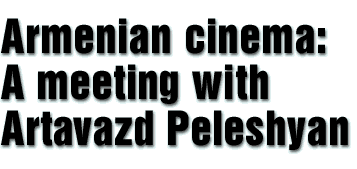|
 |
||
|
By James Norton |
On a recent visit to the Armenian capital Yerevan I was introduced to the film critic and historian Artsvi Bakhchinyan and our discussion soon turned to the documentary genius Artavazd Peleshyan who seemed to have slipped back into the obscurity from which he briefly emerged to astonished festival audiences earlier this decade. Peleshyan is a notorious recluse who dislikes publicity and interviews, and Artsvi had never met him before, but fortified by each other we approached a mutual friend and to our surprise were invited to Peleshyan's home.
Peleshyan's films, very rarely screened in Britain, are remarkable because they stare upon fundamental and cosmic themes, as titles such as We, Inhabitants, The Seasons, Our Century, Beginning, End and Life attest, edited with a mastery of scale and rhythm which makes it appear that all life on earth is swarming and blooming through the celluloid. His debut in 1964, Mountain Vigil, depicted the lives of people employed to sit on Armenian mountain sides and remove rocks which have fallen onto railway tracks, a precursor of one of his most recent projects, setting a camera on a mountain side to observe the passage of nature over several months, which has foundered on financial difficulties and what the producers consider Peleshyan's stubbornness. In 1967 Beginning, ostensibly a commemoration of the 1917 revolution, restaged the birth of cinema by involving still images which gradually begin to move. In this film Peleshyan also used archive film, which he has continued to effectively integrate with original material. We from 1969 shows the pressure of history on faces and crowds of Peleshyan's fellow Armenians. Inhabitants in 1970 is a hymn to the animal world which aspires almost to formal abstraction, clouds of silver birds pulverising the light, and The Seasons in 1972 is distinguished by repeatedly looped images of a ram hurled down cascading rapids and a haystack tumbling down a hillside, gravity becoming a film-maker's toy. The cosmic reach of Peleshyan's imagination led him in 1982 to Our Century, an account of the launching of humanity into space, featuring archive footage of American astronauts and his own footage of Soviet cosmonauts. Despite growing recognition worldwide, funding for Peleshyan's projects has been even more difficult to secure since the collapse of the USSR and he has only completed two short films in the past decade: End and Life, which are more intimate examinations of death and birth, although even the apparently inverted sequence of these films reflects a dynamic in which an end always implies another beginning.
We took a crowded, rickety bus up into the hills surrounding Yerevan and disembarked at an estate of Soviet apartment blocks, groping through the darkness between these undifferentiated hulks to try and find the right one. After dodging broken concrete and puddles and asking shadowy neighbours for directions we were there. The exterior of Peleshyan's home is dismal even by local standards, a dank, unlit staircase leading to an exterior door bearing the graffiti 'Michael Jackson' - could the Channel 4 boss himself have made an earlier pilgrimage? - and then on an inner portal a sole decorative emblem, a thistle painted white fixed to the corner of the frame. We were let in by Peleshyan's attentive wife Aida, who offered us tea. He was sitting in front of a TV watching images of Armenian churches, but the reception was so bad and the colours so lurid it was as if through a miracle of chromatography their design had been expressed from a drop of holy water on blotting paper. The apartment was small but comfortable and hosted a large collection of cuddly toys. Peleshyan, now 60, had a countenance of weathered iron and had not worked for some time, although he was eager to do so. I tentatively began to interview him with Artsvi interpreting. Understandably wary and curt to begin with, Peleshyan warmed to us gradually.
Having spent a few days amid the rocks and dust of this mythic, melancholic and hospitable land, I wondered if Peleshyan considered his to be a specifically Armenian aesthetic.
"Armenia is seen as oriental to the Europeans and European to the East." he began, "I am not only an Armenian filmmaker although obviously that is what I am; I am not a national chauvinist, in fact I am a chauvinist of cinema." ...
James Norton
with thanks to Artsvi Bakhchinyan and Gariné Torossian
Full article published in Filmwaves - Issue 10, Winter 2000. Subscribe now!
